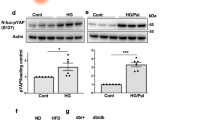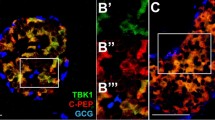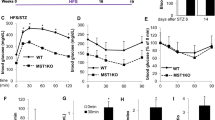Abstract
The protein p27Kip1 regulates cell cycle progression in mammals by inhibiting the activity of cyclin-dependent kinases (CDKs). Here we show that p27Kip1 progressively accumulates in the nucleus of pancreatic beta cells in mice that lack either insulin receptor substrate 2 (Irs2−/−) or the long form of the leptin receptor (Lepr−/− or db/db). Deletion of the gene encoding p27Kip1 (Cdkn1b) ameliorated hyperglycemia in these animal models of type 2 diabetes mellitus by increasing islet mass and maintaining compensatory hyperinsulinemia, effects that were attributable predominantly to stimulation of pancreatic beta-cell proliferation. Thus, p27Kip1 contributes to beta-cell failure during the development of type 2 diabetes in Irs2−/− and Lepr−/− mice and represents a potential new target for the treatment of this condition.
This is a preview of subscription content, access via your institution
Access options
Subscribe to this journal
Receive 12 print issues and online access
$209.00 per year
only $17.42 per issue
Buy this article
- Purchase on Springer Link
- Instant access to full article PDF
Prices may be subject to local taxes which are calculated during checkout





Similar content being viewed by others
References
Deng, S. et al. Structural and functional abnormalities in the islets isolated from type 2 diabetic subjects. Diabetes 53, 624–632 (2004).
Sakuraba, H. et al. Reduced β-cell mass and expression of oxidative stress-related DNA damage in the islet of Japanese Type II diabetic patients. Diabetologia 45, 85–96 (2002).
Clark, A. et al. Islet amyloid, increased A-cells, reduced B-cells and exocrine fibrosis: quantitative changes in the pancreas in type 2 diabetes. Diabetes Res. 9, 151–159 (1988).
Butler, A.E. et al. β-cell deficit and increased β-cell apoptosis in humans with type 2 diabetes. Diabetes 52, 102–110 (2003).
Kulkarni, R.N. et al. Tissue-specific knockout of the insulin receptor in pancreatic β cells creates an insulin secretory defect similar to that in type 2 diabetes. Cell 96, 329–339 (1999).
Kulkarni, R.N. et al. β-cell-specific deletion of the Igf1 receptor leads to hyperinsulinemia and glucose intolerance but does not alter β-cell mass. Nat. Genet. 31, 111–115 (2002).
Xuan, S. et al. Defective insulin secretion in pancreatic β cells lacking type 1 IGF receptor. J. Clin. Invest. 110, 1011–1019 (2002).
Withers, D.J. et al. Disruption of IRS-2 causes type 2 diabetes in mice. Nature 391, 900–904 (1998).
Kubota, N. et al. Disruption of insulin receptor substrate 2 causes type 2 diabetes because of liver insulin resistance and lack of compensatory β-cell hyperplasia. Diabetes 49, 1880–1889 (2000).
Tuttle, R.L. et al. Regulation of pancreatic β-cell growth and survival by the serine/threonine protein kinase Akt1/PKB α. Nat. Med. 7, 1133–1137 (2001).
Bernal Mizrachi, E., Wen, W., Stahlhut, S., Welling, C.M. & Permutt, M.A. Islet β cell expression of constitutively active Akt1/PKB α induces striking hypertrophy, hyperplasia, and hyperinsulinemia. J. Clin. Invest. 108, 1631–1638 (2001).
Garofalo, R.S. et al. Severe diabetes, age-dependent loss of adipose tissue, and mild growth deficiency in mice lacking Akt2/PKB β. J. Clin. Invest. 112, 197–208 (2003).
Brunet, A. et al. Akt promotes cell survival by phosphorylating and inhibiting a Forkhead transcription factor. Cell 96, 857–868 (1999).
Nakae, J. et al. Regulation of insulin action and pancreatic β-cell function by mutated alleles of the gene encoding forkhead transcription factor Foxo1. Nat. Genet. 32, 245–253 (2002).
Kitamura, T. et al. The forkhead transcription factor Foxo1 links insulin signaling to Pdx1 regulation of pancreatic β cell growth. J. Clin. Invest. 110, 1839–1847 (2002).
Sherr, C.J. & Roberts, J.M. CDK inhibitors: positive and negative regulators of G1-phase progression. Genes Dev. 13, 1501–1512 (1999).
Rane, S.G. et al. Loss of Cdk4 expression causes insulin-deficient diabetes and Cdk4 activation results in β-islet cell hyperplasia. Nat. Genet. 22, 44–52 (1999).
Nakayama, K. et al. Mice lacking p27(Kip1) display increased body size, multiple organ hyperplasia, retinal dysplasia, and pituitary tumors. Cell 85, 707–720 (1996).
Medema, R.H., Kops, G.J., Bos, J.L. & Burgering, B.M. AFX-like Forkhead transcription factors mediate cell-cycle regulation by Ras and PKB through p27kip1. Nature 404, 782–787 (2000).
Viglietto, G. et al. Cytoplasmic relocalization and inhibition of the cyclin-dependent kinase inhibitor p27(Kip1) by PKB/Akt-mediated phosphorylation in breast cancer. Nat. Med. 8, 1136–1144 (2002).
Shin, I. et al. PKB/Akt mediates cell-cycle progression by phosphorylation of p27(Kip1) at threonine 157 and modulation of its cellular localization. Nat. Med. 8, 1145–1152 (2002).
Liang, J. et al. PKB/Akt phosphorylates p27, impairs nuclear import of p27 and opposes p27-mediated G1 arrest. Nat. Med. 8, 1153–1160 (2002).
Fujita, N., Sato, S., Katayama, K. & Tsuruo, T. Akt-dependent phosphorylation of p27Kip1 promotes binding to 14-3-3 and cytoplasmic localization. J. Biol. Chem. 277, 28706–28713 (2002).
Lee, G.H. et al. Abnormal splicing of the leptin receptor in diabetic mice. Nature 379, 632–635 (1996).
Chen, H. et al. Evidence that the diabetes gene encodes the leptin receptor: identification of a mutation in the leptin receptor gene in db/db mice. Cell 84, 491–495 (1996).
Clement, K. et al. A mutation in the human leptin receptor gene causes obesity and pituitary dysfunction. Nature 392, 398–401 (1998).
Hellerstrom, C., Andersson, A. & Gunnarsson, R. Regeneration of islet cells. Acta Endocrinol. Suppl. (Copenh.) 205, 145–160 (1976).
Withers, D.J. et al. Irs-2 coordinates Igf-1 receptor-mediated β-cell development and peripheral insulin signalling. Nat. Genet. 23, 32–40 (1999).
Tanabe, K., Okuya, S., Tanizawa, Y., Matsutani, A. & Oka, Y. Leptin induces proliferation of pancreatic β cell line MIN6 through activation of mitogen-activated protein kinase. Biochem. Biophys. Res. Commun. 241, 765–768 (1997).
Zhou, B.P. et al. Cytoplasmic localization of p21Cip1/WAF1 by Akt-induced phosphorylation in HER-2/neu-overexpressing cells. Nat. Cell Biol. 3, 245–252 (2001).
Pagano, M. et al. Role of the ubiquitin-proteasome pathway in regulating abundance of the cyclin-dependent kinase inhibitor p27. Science 269, 682–685 (1995).
Cunningham, M.A., Zhu, Q. & Hammond, J.M. Foxo1a can alter cell cycle progression by regulating the nuclear localization of p27kip in granulosa cells. Mol. Endocrinol. 18, 1756–1767 (2004).
Boehm, M. et al. A growth factor-dependent nuclear kinase phosphorylates p27(Kip1) and regulates cell cycle progression. EMBO J. 21, 3390–3401 (2002).
Ishida, N. et al. Phosphorylation of p27Kip1 on serine 10 is required for its binding to CRM1 and nuclear export. J. Biol. Chem. 277, 14355–14358 (2002).
Sheaff, R.J., Groudine, M., Gordon, M., Roberts, J.M. & Clurman, B.E. Cyclin E-CDK2 is a regulator of p27Kip1. Genes Dev. 11, 1464–1478 (1997).
Vlach, J., Hennecke, S. & Amati, B. Phosphorylation-dependent degradation of the cyclin-dependent kinase inhibitor p27. EMBO J. 16, 5334–5344 (1997).
Montagnoli, A. et al. Ubiquitination of p27 is regulated by Cdk-dependent phosphorylation and trimeric complex formation. Genes Dev. 13, 1181–1189 (1999).
Fujita, N., Sato, S. & Tsuruo, T. Phosphorylation of p27Kip1 at threonine 198 by p90 ribosomal protein S6 kinase promotes its binding to 14-3-3 and cytoplasmic localization. J. Biol. Chem. 278, 49254–49260 (2003).
Wolf, G. et al. Glomerular expression of p27Kip1 in diabetic db/db mouse: role of hyperglycemia. Kidney Int. 53, 869–879 (1998).
Brownlee, M. Biochemistry and molecular cell biology of diabetic complications. Nature 414, 813–820 (2001).
Wolf, G., Wenzel, U., Hannken, T. & Stahl, R.A.K. Angiotensin II induces p27kip1 expression in renal tubules in vivo: role of reactive oxygen species. J. Mol. Med. 79, 382–389 (2001).
Herrera, P.L. Adult insulin- and glucagon-producing cells differentiate from two independent cell lineages. Development 127, 2317–2322 (2000).
Schreyer, S.A., Chua, S.C. Jr. & LeBoeuf, R.C. Obesity and diabetes in TNF-α receptor-deficient mice. J. Clin. Invest. 102, 402–411 (1998).
Matsumoto, M. et al. PKCλ in liver mediates insulin-induced SREBP-1c expression and determines both hepatic lipid content and overall insulin sensitivity. J. Clin. Invest. 112, 935–944 (2003).
Uchida, T., Myers, M.G. Jr. & White, M.F. IRS-4 mediates PKB signaling during insulin stimulation without promoting anti-apoptosis. Mol. Cell. Biol. 20, 126–138 (2000).
Acknowledgements
We thank M. Kawasaki, K. Satomura, M. Nagano and K. Kakinoki for technical assistance. This work was supported by grants for the Intellectual Cluster Formation Project and the 21st Century Center of Excellence Program “Center of Excellence for Signal Transduction Disease: Diabetes Mellitus as a Model” from the Ministry of Education, Culture, Sports, Science and Technology of Japan to M.K.
Author information
Authors and Affiliations
Corresponding author
Ethics declarations
Competing interests
The authors declare no competing financial interests.
Supplementary information
Supplementary Fig. 1
Expression of p21Cip1 in islets of Irs2−/− and Lepr−/− mice. (PDF 162 kb)
Supplementary Fig. 2
Detection of phosphorylated p27. (PDF 79 kb)
Supplementary Fig. 3
Decreased Pcna-positive β cells in RIP-p27 mice. (PDF 580 kb)
Supplementary Fig. 4
The effect of p27 deletion on apoptosis in the islets of Lepr−/− mice. (PDF 735 kb)
Supplementary Fig. 5
The effect of p27 on apoptosis in Min6 insulinoma cells. (PDF 203 kb)
Supplementary Fig. 6
Deletion of p27 increases Pcna-positive β cells in Irs2−/− mice. (PDF 673 kb)
Supplementary Fig. 7
Igf-1 and leptin each induce Akt activation in Min6 cells. (PDF 123 kb)
Supplementary Fig. 8
p27 mRNA is not increased in the islets of diabetic mice. (PDF 33 kb)
Supplementary Fig. 9
Deletion of p27 does not affect insulin resistance in Irs2−/− mice (PDF 122 kb)
Supplementary Fig. 10
Abundance of p27 in various tissues of Lepr−/− or Lepr+/− mice. (PDF 319 kb)
Rights and permissions
About this article
Cite this article
Uchida, T., Nakamura, T., Hashimoto, N. et al. Deletion of Cdkn1b ameliorates hyperglycemia by maintaining compensatory hyperinsulinemia in diabetic mice. Nat Med 11, 175–182 (2005). https://doi.org/10.1038/nm1187
Received:
Accepted:
Published:
Issue Date:
DOI: https://doi.org/10.1038/nm1187
This article is cited by
-
Association between triglyceride glucose index and total bone mineral density: a cross-sectional study from NHANES 2011–2018
Scientific Reports (2024)
-
mPGES-2 blockade antagonizes β-cell senescence to ameliorate diabetes by acting on NR4A1
Nature Metabolism (2022)
-
Diabetes and Bone Fragility
Diabetes Therapy (2021)
-
Ileal Transposition Increases Pancreatic β Cell Mass and Decreases β Cell Senescence in Diet-Induced Obese Rats
Obesity Surgery (2020)
-
The role of cellular senescence in diabetes mellitus and osteoporosis: molecular pathways and potential interventions
Hormones (2019)



